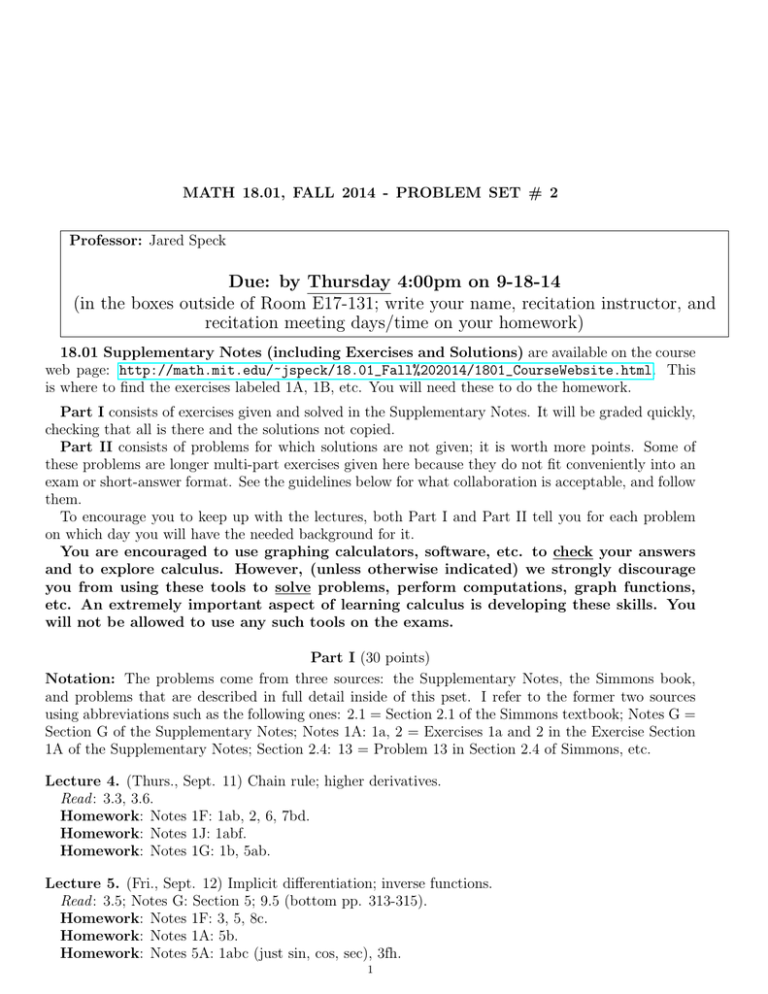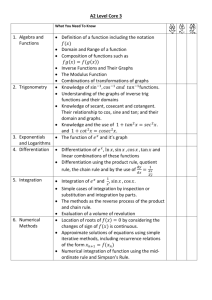Due: by Thursday 4:00pm on 9-18-14
advertisement

MATH 18.01, FALL 2014 - PROBLEM SET # 2 Professor: Jared Speck Due: by Thursday 4:00pm on 9-18-14 (in the boxes outside of Room E17-131; write your name, recitation instructor, and recitation meeting days/time on your homework) 18.01 Supplementary Notes (including Exercises and Solutions) are available on the course web page: http://math.mit.edu/~jspeck/18.01_Fall%202014/1801_CourseWebsite.html. This is where to find the exercises labeled 1A, 1B, etc. You will need these to do the homework. Part I consists of exercises given and solved in the Supplementary Notes. It will be graded quickly, checking that all is there and the solutions not copied. Part II consists of problems for which solutions are not given; it is worth more points. Some of these problems are longer multi-part exercises given here because they do not fit conveniently into an exam or short-answer format. See the guidelines below for what collaboration is acceptable, and follow them. To encourage you to keep up with the lectures, both Part I and Part II tell you for each problem on which day you will have the needed background for it. You are encouraged to use graphing calculators, software, etc. to check your answers and to explore calculus. However, (unless otherwise indicated) we strongly discourage you from using these tools to solve problems, perform computations, graph functions, etc. An extremely important aspect of learning calculus is developing these skills. You will not be allowed to use any such tools on the exams. Part I (30 points) Notation: The problems come from three sources: the Supplementary Notes, the Simmons book, and problems that are described in full detail inside of this pset. I refer to the former two sources using abbreviations such as the following ones: 2.1 = Section 2.1 of the Simmons textbook; Notes G = Section G of the Supplementary Notes; Notes 1A: 1a, 2 = Exercises 1a and 2 in the Exercise Section 1A of the Supplementary Notes; Section 2.4: 13 = Problem 13 in Section 2.4 of Simmons, etc. Lecture 4. (Thurs., Sept. 11) Chain rule; higher derivatives. Read : 3.3, 3.6. Homework: Notes 1F: 1ab, 2, 6, 7bd. Homework: Notes 1J: 1abf. Homework: Notes 1G: 1b, 5ab. Lecture 5. (Fri., Sept. 12) Implicit differentiation; inverse functions. Read : 3.5; Notes G: Section 5; 9.5 (bottom pp. 313-315). Homework: Notes 1F: 3, 5, 8c. Homework: Notes 1A: 5b. Homework: Notes 5A: 1abc (just sin, cos, sec), 3fh. 1 2 MATH 18.01, FALL 2014 - PROBLEM SET # 2 Lecture 6. (Tues., Sept. 16) Exponentials and logs: definitions, algebra, applications; logarithmic differentiation; hyperbolic functions. Read : Notes: Section X (8.2 has some of this); 8.3 to middle p. 267; 8.4 to top p. 271. Read : 9.7 to p. 326. Homework: Notes 1H: 1, 2, 3a, 5b. Homework: Notes 1I: 1cdefm, 4a. Homework: Notes 5A: 5abc (in 5a, you don’t have to find the critical points or inflection points; just provide a rough sketch). MATH 18.01, FALL 2014 - PROBLEM SET # 2 3 Part II (50 points) Directions and Rules: Collaboration on problem sets is encouraged, but: i) Attempt each part of each problem yourself. Read each portion of the problem before asking for help. If you don’t understand what is being asked, ask for help interpreting the problem and then make an honest attempt to solve it. ii) Write up each problem independently. On both Part I and II exercises you are expected to write the answer in your own words. You must show your work; “bare” solutions will receive very little credit. iii) Write on your problem set whom you consulted and the sources you used. If you fail to do so, you may be charged with plagiarism and subject to serious penalties. iv) It is illegal to consult materials from previous semesters. 0. (not until due date; 3 points) Write the names of all the people whom you consulted or with whom you collaborated and the resources you used, or say “none” or “no consultation.” This includes visits outside recitation to your recitation instructor. If you don’t know a name, you must nevertheless identify the person, as in, “tutor in Room 2-106,” or “the student next to me in recitation.” Optional: note which of these people or resources, if any, were particularly helpful to you. This “Problem 0” will be assigned with every problem set. Its purpose is to make sure that you acknowledge (to yourself as well as others) what kind of help you require and to encourage you to pay attention to how you learn best (with a tutor, in a group, alone). It will help us by letting us know what resources you use. 1. (now; slope, basic curve sketching; 1 + 2 = 3 points) a) Find an even function E(x) and an odd function O(x) such that the function f (x) = x4 /(x + 1) can be decomposed as f (x) = E(x) + O(x). b) Graph E(x). In the same picture, also provide a rough sketch of the graph of E 0 (x) without performing any computations (except to check your answer if you want). Then do the same thing for O(x) and O0 (x). 2. (Sept. 11; chain rule, higher derivatives; 4 points) A function f (x) is said to be concave up at x0 if f 00 (x0 ) > 0 (we will study this notion in detail later in the course). Suppose that f (x) is a differentiable function with f (x0 ) > 0 for all x0 . Suppose in addition that f (x) is concave up at all x0 . Show that the function g(x) = (f (x))2 is concave up at every x0 . 3. (Sept. 12; chain rule and inverse trig differentiation; 3 + 3 = 6 points) Compute the following derivatives: a) (d/dx)[arctan(x2 + x + 1)]−3 . b) (d/dy) (sin y cos y) . Do this is in two different ways: i) First do it directly. ii) Then use a trig identity to write sin y cos y = f (2y) for some trig function f (and then compute (d/dy)f (2y)). Show that your two answers agree. 4. (Sept.13; implicit differentiation; slope; 5 + 7 = 12 points) Consider the following curve in the (x, y) plane: (1/3)y 3 + xy 2 + x2 y + x3 + x = 5/3. 4 MATH 18.01, FALL 2014 - PROBLEM SET # 2 a) Find the number of points P = (x0 , y0 ) on the curve such that the tangent line to the curve at P is horizontal. b) Find the one point Q on the curve such that the tangent line to the curve at Q is vertical. Remark: You only have to find the one point; you don’t have to prove that there is only one Q. In order to prove that there is only one, you need some tools that we haven’t yet developed. 5. (Sept. 12; inverse trig functions and differentiation; 2 + 2 + 2 = 6 points) The function θ = cos−1 (x) is the inverse of cos θ for 0 ≤ θ ≤ π. Similarly, the function φ = sin−1 (x) is the inverse of sin φ for −π/2 ≤ φ ≤ π/2. a) Use implicit differentiation to find a formula for (d/dx) cos−1 (x). Pay particular attention to the sign of the square root. b) Simplify the expression sin−1 (x) + cos−1 (x) as much as possible. c) Explain how you can use parts a) and b) to quickly derive a formula for (d/dx) sin−1 (x) by doing very little additional work (you should be able to do the computation in your head). 6. (Sept. 16; logarithmic differentiation; 2 + 2 + 2 = 6 points) a) Given two functions u and v, set y = uv. Note the identity log y = log u + log v. Use this identity and logarithmic differentiation to give an alternative derivation (i.e., different than the derivation we discussed in class) of the product rule (uv)0 = u0 v + uv 0 . b) Modify the approach from part a) in order to give an alternative derivation of the quotient rule 0 0 = u v−uv . v2 u 0 v c) Suppose now that you are given n functions u1 (x), u2 (x), · · · , un (x). Modify the approach from part a) in order to derive a formula for the derivative of the product u1 u2 · · · un , i.e., a formula for (d/dx)(u1 u2 · · · un ). 7. (Sept. 16; 2 + 2 + 2 + 2 + 2 = 10 points) Section 8.2: 8ac, 10, 11; Section 8.4: 18, 20 (only compute dy/dx).




